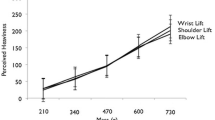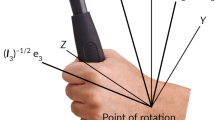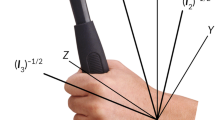Abstract
Bingham et al. discovered a perceptible affordance property, composed of a relation between object weight and size, used to select optimal objects for long-distance throwing. Subsequent research confirmed this finding, but disconfirmed a hypothesis formulated by Bingham et al. about the information used to perceive the affordance. Following this, Zhu and Bingham investigated the possibility that optimal objects for throwing are selected as having a particular felt heaviness. The results supported this hypothesis. Perceived heaviness exhibits the size–weight illusion: to be perceived as equally heavy, larger objects must weigh more than smaller ones. Amazeen and Turvey showed that heaviness perception is determined by rotational inertia. We investigated whether rotational inertia would determine both perceived heaviness and throw-ability when spherical objects were held in the hand and wielded about the wrist. We found again that a particular judged heaviness corresponded to judged throw-ability. However, rotational inertia was found to have no effect on either judgment, suggesting that rotational inertia does not determine perceived heaviness of spherical objects held in the hand, as it did for the weighted-rod-type objects used by Amazeen and Turvey.



Similar content being viewed by others
Notes
To heft an object, participants held it in the hand and oscillated it around the wrist or oscillated the elbow to cause the hand to bounce at the wrist. See Bingham, et al. (1989) or Zhu and Bingham (2008, 2010) for additional details. Bingham et al. (1989) first piloted the judgment in a free response condition to see what participants would do naturally to perform the judgment task. The experimenters then adopted what they observed these participants to do and regularized it, so all future participants would then perform the same relatively simple but nevertheless representative action.
Note that Kingma et al. (2002, 2004) showed perceptual sensitivity to the first moment of inertia (mass × [distance of center of mass from point of rotation]1), while Amazeen and Turvey (1996) and Shockley et al. (2001, 2004) showed perceptual sensitivity to the second moment of inertia (mass × [distance of center of mass from point of rotation]2). The salience hypothesis of van de Langenberg et al. (2006) may account for these differing results. However, at issue presently is the fact that both first and second moments of inertia are functions of the mass distribution. Thus, the fact that inertia variables influence perceived heaviness may account for previously observed size–weight influences on heaviness reports.
This hypothesis was suggested to Zhu and Bingham by Eric Amazeen who was acting as a reviewer of Zhu and Bingham (2010).
A previous study (Zhu and Bingham 2008) showed that normally skilled throwers can throw an object like a tennis ball to an average of 95 feet, equivalent to the length of a basketball court.
The rotation about all major finger knuckles was restricted so that only wrist was involved in hefting motion.
Participants were told nothing about variations in mass locations or rotational inertias, nor, in general, did they have any awareness of these variations as such. They did, of course, know that objects were varying in size and weight.
In Experiment 1 of Amazeen and Turvey’s study (1996), rods with attached masses were used. Based on the mass and dimension of the rod, for an attached mass of 50 g (the middle magnitude), the corresponding magnitudes rotational inertia for the three different mass displacements (20, 40 and 60 cm from the proximal end of the rod) were 53.89, 113.89 and 213.89 in kg m2 × 104, the range of which is 160 kg m2 × 104. For the objects of greatest mass magnitude in the present study, the corresponding magnitudes of rotational inertia for the three mass locations (near, center and far) were 54.97, 161.61 and 341.32 in kg m2 × 104, the range of which is 286.35 kg m2 × 104.
This approach was developed in Bingham et al. (1989) to compensate for the necessarily discrete way that the objects sampled potential variation in weight, a continuous variable. The weighted average allows a better estimate of the actual preferred or optimal weight value.
For judgments of equal heaviness, the mean preferred mass or inertia for the series of objects from which the comparison object was selected was the mass or inertia of the comparison objects themselves, that is, the first choice object from the previous throwing judgment test.
Since previous work (e.g., Shockley et al. 2001) showed that perception of heaviness is also constrained by symmetry of the inertial ellipsoid along with mass, we performed analysis for potential effects of symmetry and found, as expected by design, that it did not play a significant role in determining the judgments.
We adapt this term from geometry.
References
Amazeen E (1997) The effects of volume on perceived heaviness by dynamic touch: with and without vision. Ecol Psychol 9:245–263
Amazeen EL, Turvey MT (1996) Weight perception and the haptic size-weight illusion are functions of the inertia tensor. J Exp Psychol Hum 22:213–232
Bingham GP, Schmidt R, Rosenblum L (1989) Hefting for a maximum distance throw: a smart perceptual mechanism. J Exp Psychol Hum 15:507–528
Carello C, Thuot S, Anderson KL (1999) Perceiving the sweet spot. Perception 28:307–320
Davis CM, Brickett P (1977) The role of preparatory muscle tension in the size-weight illusion. Percept Psychophys 20:33–36
Flanagan JR, Beltzner MA (2000) Independence of perceptual and sensorimotor predictions in the size-weight illusion. Nat Neurosci 3:737–741
Hove P, Riley MA, Shockley K (2006) Perceiving affordances of hockey sticks by dynamic touch. Ecol Psychol 18:163–189
Kingma I, Beek P, van Dieen JH (2002) The inertia tensor versus static moment and mass in perceiving length and heaviness of hand-wielded rods. J Exp Psychol Hum 28:180–191
Kingma I, van de Langenberg R, Beek P (2004) Which mechanical invariants are associated with the perception of length and heaviness of a nonvisible handheld rod? Testing the inertia tensor hypothesis. J Exp Psychol Hum 30:346–354
Michaels CF, Weier Z, Harrison SJ (2007) Using vision and dynamic touch to perceive the affordances of tools. Perception 36:750–772
Ross HE (1966) Sensory information necessary for the size-weight illusion. Nature 212:650
Shockley K, Grocki M, Carello C, Turvey MT (2001) Somatosensory attunement to the rigid body laws. Exp Brain Res 136:133–137
Shockley K, Carello C, Turvey MT (2004) Metamers in the haptic perception of heaviness and moveableness. Percept Psychophys 66:731–742
Turvey MT, Shockley K, Carello C (1999) Affordance, proper function and the physical basis of perceived heaviness. Cognition 73:B17–B26
Van de Langenberg R, Kingma I, Beek P (2006) Mechanical invariants are implicated in dynamic touch as a function of their salience in the stimulus flow. J Exp Psychol Hum 32:1093–1106
Wagman JB, Carello C (2001) Affordances and inertial constraints on tool use. Ecol Psychol 13:173–195
Wagman JB, Shockley K (2011) Metamers for hammer-with-ability are not metamers for poke-with-ability. Ecol Psychol 23:76–92
Zhu Q, Bingham GP (2008) Is hefting for throwing a smart mechanism? J Exp Psychol Hum 34:929–943
Zhu Q, Bingham GP (2009) Investigating the information used to detect an affordance for maximum distance throws. In: Wagman J, Pagano C (eds) Stud percept action X. Erlbaum, Hillsdale, pp 122–126
Zhu Q, Bingham GP (2010) Learning to perceive the affordance for long-distance throwing: smart mechanism or function Learning? J Exp Psychol Hum 36:862–875
Zhu Q, Bingham GP (2011) Human readiness to throw: the size-weight illusion is not an illusion when picking the best objects to throw. Evol Hum Behav 32:288–293
Zhu Q, Dapena J, Bingham GP (2009) Learning to throw to maximum distances: do release angle and speed reflect affordances for throwing? Hum Mov Sci 28:708–725
Acknowledgments
We thank the staff of the Research Support Workshop in the Department of Psychological and Brain Sciences at Indiana University for manufacturing the objects used in this study. We thank Elizabeth Brettschneider at the University of Cincinnati for her assistance with data collection. KDS, MAR and MTT were supported by NSF grants BCS-0716319, BCS-0926662 and BCS-0728743.
Author information
Authors and Affiliations
Corresponding author
Rights and permissions
About this article
Cite this article
Zhu, Q., Shockley, K., Riley, M.A. et al. Felt heaviness is used to perceive the affordance for throwing but rotational inertia does not affect either. Exp Brain Res 224, 221–231 (2013). https://doi.org/10.1007/s00221-012-3301-7
Received:
Accepted:
Published:
Issue Date:
DOI: https://doi.org/10.1007/s00221-012-3301-7




